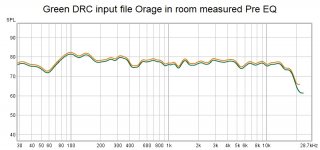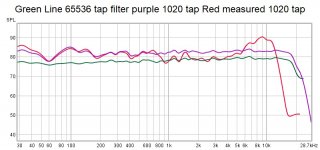This image makes me think that there were 2040 taps allocated and loading the filter would take it to 4080. Which would make sense as the filter was 2040 samples (checked with Audacity). Maybe try to unload FIR to reset taps used and then load the filter.
I hope we get through the loading part so you can tell me if it sounds any good 🙂
Each output FIR minimum tap count is 6, which leave a total of 4078 to be allocated at will. I did try a couple more times to clear taps and import to one channel atleast but no-go. Thanks for the files through PM, will be able to test this afternoon 🙂
Mk3 looks interesting. There could very well be some merits in the what looks like an asymmetric chamber. Thats carbon - right? Cool but can carbon ring in a quite nasty way....
How about a chamber that has the shape of an exponential horn where the driver sits in the mouth and its backside plays into the "reversed" horn. A bit like the midrange in the B&W speakers.
How about a chamber that has the shape of an exponential horn where the driver sits in the mouth and its backside plays into the "reversed" horn. A bit like the midrange in the B&W speakers.
Last edited:
Mk3 dont have any material considerations as of yet, just shape doodling in CAD. Opted for a visual, high gloss/deep black look just to get a feel for it.
Carbon fiber would not bring much to the table because its tensile strength isnt needed for the cabinet. So we agree 🙂
I do actually plan to use an internal baffle to extend the camber/reversed horn 😀
By plan I mean "if I'll ever build them..."
I do have two rectangular setups done...and dont mind curves...
But have three major obstacles before an mk3 is even seriously considered:
In other words, all thats required is time 🙂
When I built mk1 I had mk2 plans, it took 5yrs for that to realize, so mk3 in 2025 perhaps?
Carbon fiber would not bring much to the table because its tensile strength isnt needed for the cabinet. So we agree 🙂
I do actually plan to use an internal baffle to extend the camber/reversed horn 😀
By plan I mean "if I'll ever build them..."

I do have two rectangular setups done...and dont mind curves...
But have three major obstacles before an mk3 is even seriously considered:
- Money,
- Money,
- and Money
In other words, all thats required is time 🙂
When I built mk1 I had mk2 plans, it took 5yrs for that to realize, so mk3 in 2025 perhaps?
Last edited:
I think carbon fibre has interesting properties for enclosure construction. Not for strength reasons, but for stiffness reasons.Mk3 dont have any material considerations as of yet, just shape doodling in CAD. Opted for a visual, high gloss/deep black look just to get a feel for it.
Carbon fiber would not bring much to the table because its tensile strength isnt needed for the cabinet. So we agree 🙂
I do actually plan to use an internal baffle to extend the camber/reversed horn 😀
By plan I mean "if I'll ever build them..."
I do have two rectangular setups done...and dont mind curves...
But have three major obstacles before an mk3 is even seriously considered:
- Money,
- Money,
- and Money
In other words, all thats required is time 🙂
When I built mk1 I had mk2 plans, it took 5yrs for that to realize, so mk3 in 2025 perhaps?
Let's say you make the enclosure of layered plywood (wesayso-style), then you have very low stiffness due to wood fibers being in the wrong direction. This can be countered with very thick walls. But could also be countered with laminating both sides with carbon/epoxy.
/Anton
Absolutely, as a part-of construction CF can be put to good use.
The shape is loosely inspired by Franco Serblin, but I wanted a more "aeroplane wing shape" to is since I'm a pilot (recreational) 🙂
Since shape is curved to begin with I also consider an angled front baffle so the line acousticly have toe-in while standing "straight".
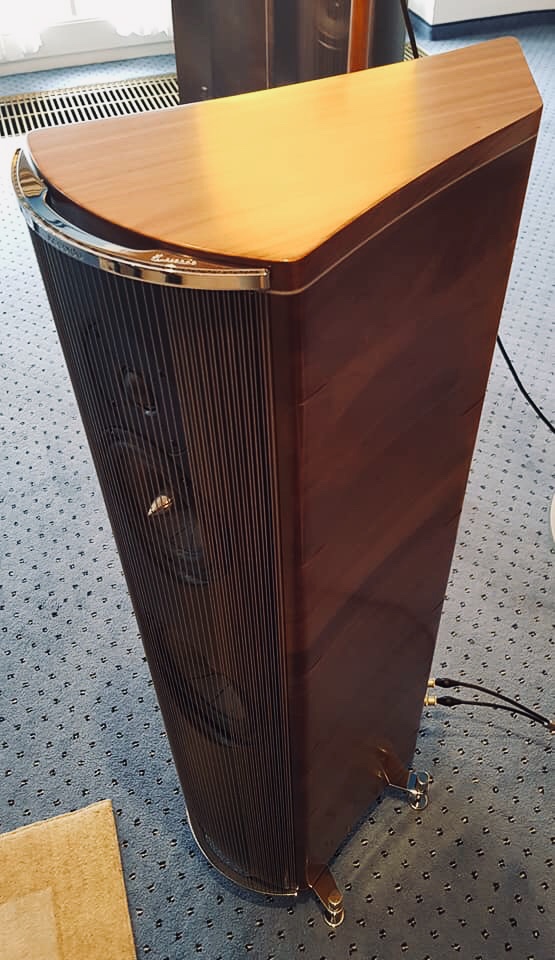
The shape is loosely inspired by Franco Serblin, but I wanted a more "aeroplane wing shape" to is since I'm a pilot (recreational) 🙂
Since shape is curved to begin with I also consider an angled front baffle so the line acousticly have toe-in while standing "straight".

Last edited:
I suspect version three might come earlier than you are hinting at. Although, I am not so sure about the performance benefits (they will most likely be minimal) - I do think this needs to happen just for the sake of the artistry of it.
Mk1 never got its baffles painted and mk2 deserve closure 😀
That means living with them, finalize the EQ, making the rear wall, speaker connectors etc, all those minor things... Then viscoelastic (VS) barrier + dark baffle paint. The VS-seals will act as a paint mask, covering the interiour.
I have one area more to address, and that is more EG at the rear chamber wall. I have space for this on the "outside" where wiring is done. So there is weight gain coming
Cant wait to try fluids's filters and see if my miniDSP can utilize them, most curious as to what FIR filters can bring to the table 🙂
Had an hr in front of them yesterday and with minimal EQ'ing I have a really good configuration going on. I have pulled the speakers out further from the wall than previous (since the past week 105cm out in total) with about 10deg toe-in. This have provided a really satisfying baseline with a very refined width/depth field of "view", especially when I sit upright bringing my ears a little further out from rear wall.
Tracks from Melody Gardot, Jean-Michel Jarre, Jan Garbarek to name a few...simply sound wonderful and put a big smile on my face. Even music I generally dont care much for have increased entertainment value 😱
It could happen...but I have a lot of things that I need to get done before shifting focus too much 😉
Yes, mk3 would primarely be considered for change of appearance. I really like the classic rectangular look of my mk2's, but dont dislike deep gloss, black and curves either...
I love to build, so for that reason alone an mk3 could absolutely happen.
That means living with them, finalize the EQ, making the rear wall, speaker connectors etc, all those minor things... Then viscoelastic (VS) barrier + dark baffle paint. The VS-seals will act as a paint mask, covering the interiour.
I have one area more to address, and that is more EG at the rear chamber wall. I have space for this on the "outside" where wiring is done. So there is weight gain coming

Cant wait to try fluids's filters and see if my miniDSP can utilize them, most curious as to what FIR filters can bring to the table 🙂
Had an hr in front of them yesterday and with minimal EQ'ing I have a really good configuration going on. I have pulled the speakers out further from the wall than previous (since the past week 105cm out in total) with about 10deg toe-in. This have provided a really satisfying baseline with a very refined width/depth field of "view", especially when I sit upright bringing my ears a little further out from rear wall.
Tracks from Melody Gardot, Jean-Michel Jarre, Jan Garbarek to name a few...simply sound wonderful and put a big smile on my face. Even music I generally dont care much for have increased entertainment value 😱
I suspect version three might come earlier than you are hinting at. Although, I am not so sure about the performance benefits (they will most likely be minimal) - I do think this needs to happen just for the sake of the artistry of it.
It could happen...but I have a lot of things that I need to get done before shifting focus too much 😉
Yes, mk3 would primarely be considered for change of appearance. I really like the classic rectangular look of my mk2's, but dont dislike deep gloss, black and curves either...
I love to build, so for that reason alone an mk3 could absolutely happen.
Last edited:
Buzy at home, but have had the chance to drop into listening mode on a few occations.
Fluid have been provided some test filters for me to use after I provided him with a few REW-measurements, very generous as this workflow is still very unfamiliar terrain to me 😱
My preception of these filters, (PreQE filters and FIR-filters) are very good indeed and I really dig them 🙂 It is not night and day difference from my earlier, plain EQ, configuration, but there is change, and improvement from an already grin-generating setup 🙂
My primary parameter for "success" is how tired I am in the morning 😴
Quite often "half an hr" = 2hrs and into the AM 😀
Success in this regard is ear pleasure when using...
Here is a track which have an intro that sound truly wonderful to me, with a lot going on in terms of space perception / "audio reality":
YouTube
Fluid have been provided some test filters for me to use after I provided him with a few REW-measurements, very generous as this workflow is still very unfamiliar terrain to me 😱
My preception of these filters, (PreQE filters and FIR-filters) are very good indeed and I really dig them 🙂 It is not night and day difference from my earlier, plain EQ, configuration, but there is change, and improvement from an already grin-generating setup 🙂
My primary parameter for "success" is how tired I am in the morning 😴
Quite often "half an hr" = 2hrs and into the AM 😀
Success in this regard is ear pleasure when using...
Here is a track which have an intro that sound truly wonderful to me, with a lot going on in terms of space perception / "audio reality":
YouTube
I have made Halair some new filters which I hope he will be able to load into the MiniDSP 
It has been quite difficult to work it out without having the hardware to test myself
The limited number of taps and 96k fixed sample rate has presented an issue in making a good filter and I am pleased that the effort has been worthwhile for Halair so far 🙂
Based on my own efforts to make a psycho smoothed filter I thought I would make one based on Halair's measurements and try to make the overall filter closer in shape to one I would be able to make with more taps.
The filter I would make if taps were not an issue is quite detailed down to the low frequencies, with the tap limit it starts to deviate below 1K.
I have had some success at least on paper at combining PEQ and FIR to get the overall transfer curve I was aiming for.
I started with the psycho smoothed filter as a base, I convolved that with the PreEQ that the measurements were based on to allow DRC to be in a good range for filter generation. That is the control.
In REW I divided the control filter by the one that was made for the MiniDSP to create a difference file.
I inverted the difference file (1/A). This is the EQ curve I needed to generate.
I used the auto EQ with target level set to 0dB and target type to none. I limited the match range to best fit the biggest issues as there are limited PEQ's to play with. Matched to target and checked that the filters matched the shape which they did. Export those to a biquad file and make an impulse of them to convolve with the original low tap filter as a check.
On paper it works. Excess phase correction below 1k is almost none existent so far. That will need a new strategy.

It has been quite difficult to work it out without having the hardware to test myself

The limited number of taps and 96k fixed sample rate has presented an issue in making a good filter and I am pleased that the effort has been worthwhile for Halair so far 🙂
Based on my own efforts to make a psycho smoothed filter I thought I would make one based on Halair's measurements and try to make the overall filter closer in shape to one I would be able to make with more taps.
The filter I would make if taps were not an issue is quite detailed down to the low frequencies, with the tap limit it starts to deviate below 1K.
I have had some success at least on paper at combining PEQ and FIR to get the overall transfer curve I was aiming for.
I started with the psycho smoothed filter as a base, I convolved that with the PreEQ that the measurements were based on to allow DRC to be in a good range for filter generation. That is the control.
In REW I divided the control filter by the one that was made for the MiniDSP to create a difference file.
I inverted the difference file (1/A). This is the EQ curve I needed to generate.
I used the auto EQ with target level set to 0dB and target type to none. I limited the match range to best fit the biggest issues as there are limited PEQ's to play with. Matched to target and checked that the filters matched the shape which they did. Export those to a biquad file and make an impulse of them to convolve with the original low tap filter as a check.
On paper it works. Excess phase correction below 1k is almost none existent so far. That will need a new strategy.
It has been quite difficult to work it out without having the hardware to test myself
Add opposite sides of the planet, different time zone / season and the stage is set for a little

New filters receieved, will know how they import later tonite 🙂
I have only managed to import them, initial impression is that they were "off". I havent added a house curve to them yet, in case that may later things.
Fluid's previous iteration of filters however "feel" very right and most pleasing so I have a firm baseline 😀
No time to spend in front of the arrays this weekend, birthday for my better half + Mothers day yesterday...😉
In other words nothing quantifiable to report 🙂
Fluid's previous iteration of filters however "feel" very right and most pleasing so I have a firm baseline 😀
No time to spend in front of the arrays this weekend, birthday for my better half + Mothers day yesterday...😉
In other words nothing quantifiable to report 🙂
Last edited:
Something is going wrong in the translation from DRC filter to MiniDSP output
I was starting to think maybe I had used the wrong base measurement so I double checked, no very good match, this is the difference between the measured pre EQ'd response Halir sent vs the DRC input pcm file. They are the same.
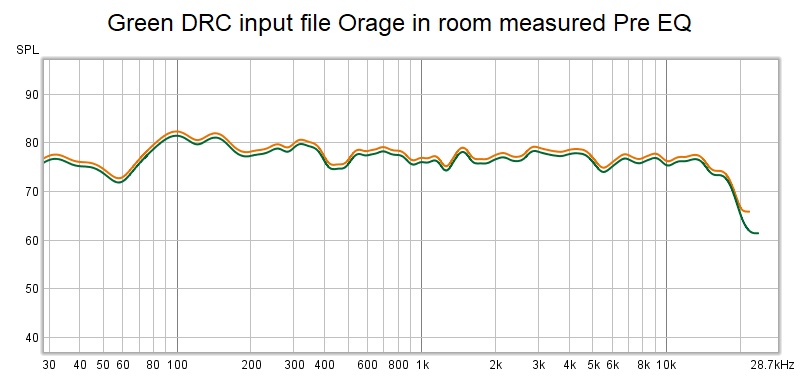
Here is a comparison between what I am aiming for with the correction in the green line. Pretty flat with a very slight rise. Vs what I can get from 1020 taps in purple Vs what the MiniDSP is putting out when measured in room. Up to 600Hz is near enough then it all goes wrong Hmmm 🙁
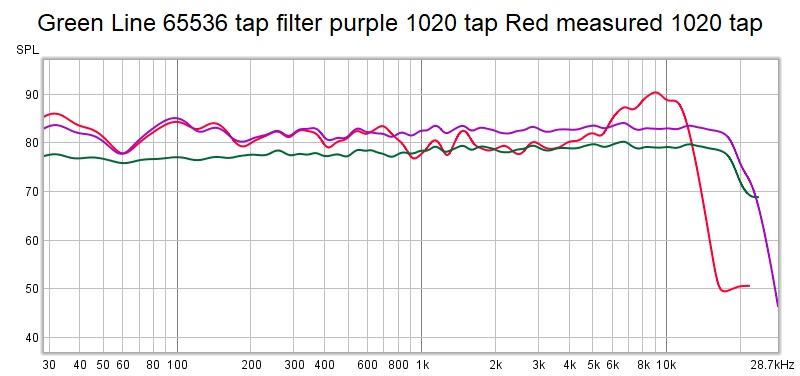
I suspect that the psycho filter is not doing what was intended either which should have been another version of a straight line with more dips in it.
For now I have put aside the psycho filters in my own system as they have not been able to outperform the good old trusty one which is what I was trying to give to Halair here in these graphs.
I was starting to think maybe I had used the wrong base measurement so I double checked, no very good match, this is the difference between the measured pre EQ'd response Halir sent vs the DRC input pcm file. They are the same.
Here is a comparison between what I am aiming for with the correction in the green line. Pretty flat with a very slight rise. Vs what I can get from 1020 taps in purple Vs what the MiniDSP is putting out when measured in room. Up to 600Hz is near enough then it all goes wrong Hmmm 🙁
I suspect that the psycho filter is not doing what was intended either which should have been another version of a straight line with more dips in it.
For now I have put aside the psycho filters in my own system as they have not been able to outperform the good old trusty one which is what I was trying to give to Halair here in these graphs.
Attachments
I also notice that sharp fall off from 12K in your MiniDSP screenshots you sent me of the psycho filter so there is something funky going on, it should not be doing that until nearer 20K.
I appreciate your efforts fluid 
Your first set of PreEQ/FIR filters are what I prefer the most so far by ear, and I have yet to try experimenting with a house curve applied on top.
(Other than a LowShelf filter from 120hz to boost bottom for movies)
Next week I am away, gone skiing and little prospect of serious time in front of the arrays prior to that. If you would like any data from me prior to that, let me know.
the miniDSP2x4HD have a total of 4096 taps available, freely distributable over the 4 output channels. However minimum 6 taps are used so the total available for 2 outputs are 4084. For some reason the 2040tap attempts have been unable to load as miniDSP report back 4080taps and insufficient space available.

Your first set of PreEQ/FIR filters are what I prefer the most so far by ear, and I have yet to try experimenting with a house curve applied on top.
(Other than a LowShelf filter from 120hz to boost bottom for movies)
Next week I am away, gone skiing and little prospect of serious time in front of the arrays prior to that. If you would like any data from me prior to that, let me know.
the miniDSP2x4HD have a total of 4096 taps available, freely distributable over the 4 output channels. However minimum 6 taps are used so the total available for 2 outputs are 4084. For some reason the 2040tap attempts have been unable to load as miniDSP report back 4080taps and insufficient space available.
Last edited:
If you guys can get loop back measurements with the MiniDSP inline to work, testing would be faster. One can even feed it with a measured IR to get an idea of what to expect.
I bet fluid knows what I'm getting at. Sort of virtual measurement sessions.
I bet fluid knows what I'm getting at. Sort of virtual measurement sessions.
If you guys can get loop back measurements with the MiniDSP inline to work, testing would be faster. One can even feed it with a measured IR to get an idea of what to expect.
I bet fluid knows what I'm getting at. Sort of virtual measurement sessions.
I could set up my PC with Teamviewer and allow remote access

- Home
- Loudspeakers
- Full Range
- HalAir Aeralis - Fullrange Line Array (Vifa TC9-18-08)
